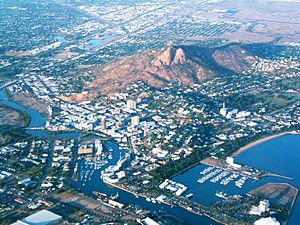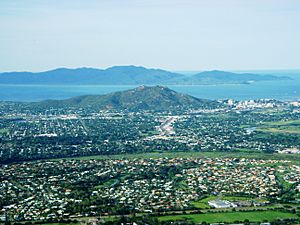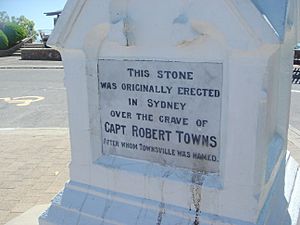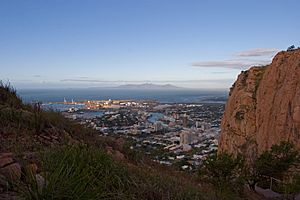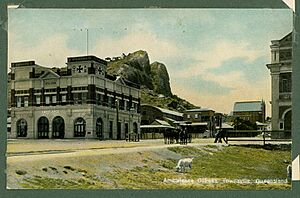Castle Hill, Townsville facts for kids
Castle Hill is a very special, big pink rock hill in Townsville, Queensland, Australia. It's known by its Indigenous name, Cootharinga, which means "possum dreaming."
This amazing hill rises about 286 meters (938 feet) above the sea. It's a huge landmark that you can see from all over the city. From the top, you get incredible views of Townsville and across Cleveland Bay to Magnetic Island. Castle Hill is so important that it was added to the Queensland Heritage Register in 1993.
Contents
What Makes Castle Hill Special?
Castle Hill is a very old, tall hill made of rock that stands out from the flatter land around it. It's mostly bare rock or has thin soil. The hill has three main peaks at the top. There used to be a quarry (where rocks are dug out) on one side. On another side, there's a large painting of 'The Saint' character on the cliff face.
A paved road called "Castle Hill Road" winds for about 2.6 kilometers (1.6 miles) to the top. At the summit, there's a viewing platform called Hynes Lookout, where you can enjoy the scenery.
There are also a few buildings and structures on the hill. An old restaurant building was once there but has since been taken down. You can still find water tanks and several radio towers that help with communication for different services. On the highest peak, there's an old observation post from 1942. It's a small concrete bunker with openings for looking out.
The Robert Towns Monument
Robert Towns was the person who helped start Townsville. He passed away in Sydney in 1873. Many years later, in 1940, the council in Sydney decided to turn the cemetery where he was buried into a park.
In 1941, the Townsville City Council was offered the monument from Robert Towns' grave. They agreed to bring it to Townsville in January 1942. Some people thought it was a good idea, but others argued that Robert Towns hadn't done much for Townsville. A local resident suggested placing the monument "high on the peak of Castle Hill, overlooking the harbour."
After arriving in Townsville, the monument was stored for several years. Finally, in October 1947, the council decided to place it on Castle Hill. The Queensland Government approved this in February 1948. The monument was officially placed on Castle Hill in November 1949, where it still stands today. A plaque was added to tell its interesting story.
Plants on Castle Hill
Castle Hill is home to many native plants, with about 300 different types identified. Some are very special:
- A unique orchid called Sarcochilus ceciliae was first found here by a famous botanist in 1865.
- Two types of grass, Aristida sp. nov. and Arthragrostis sp. nov., are only found on Castle Hill. Scientists are still studying them to see if they are new species.
- A spiky grass called Triodia usually grows inland, but it's found here by the coast, which is unusual.
The hill mostly has different kinds of eucalyptus trees, along with other small trees and bushes. In some wet, sheltered spots like gullies, you can find thick vines and plants that are not originally from the area. On the gentler slopes, kangaroo grass is common, while giant spear grass grows on the steeper parts. Special plants also grow on the cliffs and rocky areas, including five types of fig trees and two types of orchids.
Animals on Castle Hill
While not fully studied, Castle Hill is home to some interesting animals. You might spot the unadorned rock-wallaby, which is a type of wallaby that lives among rocks.
More than 50 types of birds have been seen living or visiting the hill. Peregrine falcons, known for their speed, and brahminy kites, a type of bird of prey, build their nests here. Other animals like echidnas, death adders (a type of snake), and quail have also been seen.
Fun Things to Do on Castle Hill
Many people in Townsville love to walk or run up Castle Hill for exercise. There are several ways to reach the top, either by the paved road or by rougher paths called "goat tracks." One famous goat track has 758 stairs!
Castle Hill is also a popular spot for tourists. School groups often visit to learn about nature, local history, and how cities are built. A local group called the North Queensland Conservation Council works to help native plants grow back on the hill.
Castle Hill's History
Early Days and Becoming a Reserve
Castle Hill has had other names in the past, like Cutheringa and Cudtheringa. The Aboriginal history of Cootharinga is not fully recorded, but its name is one of only two known Indigenous place names in the Townsville area.
Andrew Ball, one of the first Europeans to explore the area in 1864, named Castle Hill. The settlement that grew here was first called Castletown before becoming Townsville in 1865. Some believe Ball named it because it reminded him of a hill in the Isle of Man or near Dublin.
People in Townsville have always loved Castle Hill. It helped shape the city's streets and was a popular place for enjoying nature. However, people also illegally cut down trees for timber and firewood. Wild goats also damaged the native plants. By the late 1880s, many people were worried about the hill losing its trees.
To protect the hill, the Townsville Municipal Council asked to make it a special reserve. On June 30, 1890, Castle Hill became a Recreation Reserve. Even with rangers and tree protectors, it was hard to restore the trees during tough economic times in the 1890s. Some people privately planted trees, including the large banyan trees you can still see today.
In the 1930s, the council started to focus more on Castle Hill. The goats were removed, allowing plants to grow back naturally. From 1935 to 1936, a road to the summit was built, which also helped create jobs. This road and lookout were named after the Minister for Labour and Industry at the time, Maurice Hynes.
World War II Role
During World War II, Castle Hill was an important spot for communication and watching for enemies. Australian soldiers were stationed on the hill, and they built the observation post that is still there today. In 1942, a radar station was set up at the top, and searchlights were placed halfway up the hill. The road up Castle Hill was closed to traffic in March 1942 to build military structures.
Modern Changes
Since the 1950s, parts of the reserve have been used for other things. More water tanks were built, and some areas were used for quarrying. A restaurant, car parks, communication towers, and even some houses were built on or near the hill. By 1972, the reserve was smaller than it used to be. Since 1974, radio towers on the summit have helped services like the Civil Aviation Safety Authority, ambulance, fire brigade, police, and emergency services communicate.
In 1983, a company was given permission to develop another part of the foothills for homes. This area, called Yarrawonga, is known for its expensive houses with great views of North Ward and Magnetic Island.
There have even been a couple of ideas to make Castle Hill taller so it could officially be called a mountain!
Heritage Status
Castle Hill was officially added to the Queensland Heritage Register on May 28, 1993, recognizing its importance.



